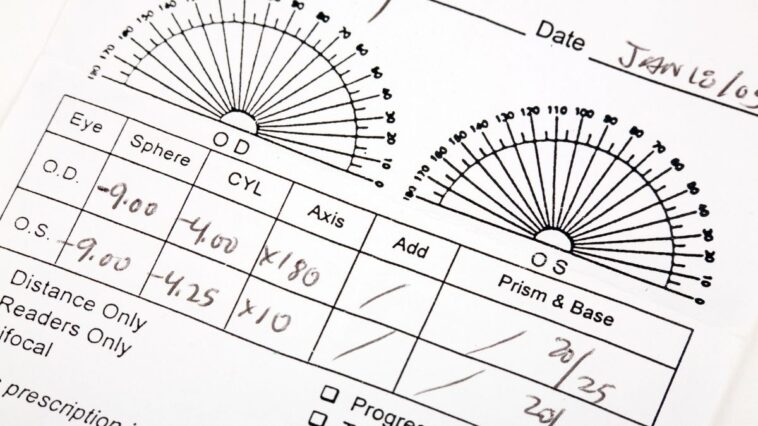If you have been prescribed glasses or contact lenses, you must know how to read your eye prescription to get the right lenses. Understanding your eye prescription can be a bit confusing, especially if you are unfamiliar with the terminology used by eye doctors. This article will provide a detailed guide on how to read your eye prescription and what each term means.
Understand the basics of vision correction.
Vision correction is correcting various visual impairments to improve a person’s vision. It involves using glasses, contact lenses, or corrective eye surgery to help the eyes focus correctly on objects at different distances. Vision impairments such as nearsightedness, farsightedness, astigmatism, and presbyopia can affect a person’s ability to perform daily activities and lead to eye strain, headaches, and other discomforts.
Glasses and contact lenses are the most common methods of vision correction. They adjust how light enters the eye, allowing the eyes to focus correctly.
Different lenses are available, including single-vision lenses for correcting nearsightedness, farsightedness, astigmatism and multifocal lenses for correcting presbyopia. In addition to lenses, glasses, and contacts can have coatings or tints that provide additional benefits, such as UV protection or reduced glare.
Corrective eye surgery is another option for vision correction, which involves reshaping the cornea using lasers or other techniques to improve vision. Regular eye exams are essential to determine if vision correction is necessary and to detect any underlying eye conditions or diseases that may require treatment.
What is an Eye Prescription?
An eye prescription is a written document containing information about your eyes and the type of correction needed to correct your vision. The prescription is usually given to you by an eye doctor or optometrist after a comprehensive eye exam. The prescription is written in a standardized format that all eye doctors use.
The prescription contains several abbreviations and numbers describing the nature of your vision problem and the required correction type. The prescription includes the following:
- The power of the lenses is needed.
- The type of lenses.
- Any other information that is necessary to make the lenses.
The Difference Between OD and OS
OD and OS are abbreviations commonly used in eye prescriptions to refer to the right and left eyes, respectively. The abbreviations stand for “oculus dexter” and “oculus sinister,” which are Latin words meaning “right eye” and “left eye,” respectively. Understanding the difference between OD and OS is essential when reading an eye prescription and ordering glasses or contact lenses.
The OD and OS designations are used to specify the prescription for each eye separately. For example, if the prescription for the right eye is -2.50 and the prescription for the left eye is -3.00, the eye doctor would write “OD -2.50, OS -3.00” on the prescription. It is important to note that the order of the letters can vary depending on the eye doctor’s preference, but the meaning remains the same.
When ordering glasses or contact lenses, it is vital to ensure that the prescriptions for the right and left eyes are correctly matched to the corresponding lenses. Failure to do so can result in blurry vision, eye strain, headaches, and other discomforts. Eye prescriptions are typically valid for a year or two, and it is recommended to have regular eye exams to ensure that the prescription is up-to-date and accurate.
How to Read Eye Prescription
Your eye prescription may initially look confusing, but it is easy to understand once you know what each term means. Here is a step-by-step guide on how to read your eye prescription:
Step 1: Check the Right and Left Eye
The first thing you need to do is to determine which eye the prescription is for. Eye prescriptions usually include separate information for the right and left eyes. The right eye is usually abbreviated as “OD” (oculus dexter), and the left eye is abbreviated as “OS” (oculus sinister).
Step 2: Determine the Spherical Power
The spherical power is the first number you will see on your prescription. It is usually abbreviated as “SPH.” The spherical power indicates the strength of the lens required to correct your nearsightedness (myopia) or farsightedness (hyperopia). The power is measured in units of diopters (D).
If the number is negative, you are nearsighted, and the lenses will be concave. If the number is positive, you are farsighted, and the lenses will be convex.
Step 3: Check the Cylinder Power
The cylinder power is the second number you will see on your prescription. It is usually abbreviated as “CYL.” The cylinder power indicates the lens’s strength required to correct your astigmatism. Astigmatism is a common vision problem when the cornea is not perfectly round, resulting in blurred or distorted vision.
The cylinder power is also measured in diopters and can be negative or positive. If the number is positive, the astigmatism is in the same meridian as the eye’s axis. If the number is negative, the astigmatism is in the opposite meridian of the eye’s axis.
Step 4: Determine the Axis
The axis is the third number you will see on your prescription. It is usually abbreviated as “AXIS.” The axis indicates the direction of the cylinder power needed to correct your astigmatism. The axis is measured in degrees from 0 to 180.
Step 5: Check the Add Power
The added power is the fourth number you will see on your prescription. It is usually abbreviated as “ADD.” The added power is used for patients with presbyopia, where the eye loses its ability to focus on near objects due to aging.
The added power is measured in diopters and is always a positive value. It indicates the additional strength of the lens needed for near-vision tasks, such as reading.
Step 6: Determine the Pupillary Distance
The pupillary distance (PD) is the distance between the centers of your pupils. It is an essential measurement for making the lenses fit perfectly on your eyes. The PD is usually given as a single number or two numbers separated by a slash. For example, if your PD is 64/60, your right eye PD is 64mm, and your left eye PD is 60mm.
Step 7: Determine the Prism Correction (if needed)
If you have a misalignment of your eyes, your eye doctor may prescribe prism correction to help align your eyes. The prism correction is usually given as a fraction, such as 1/2, followed by the direction of the prism, such as up or down.
Step 8: Check the Lens Type
Your prescription may also indicate the type of lenses that are needed. Many lenses are available, including single-vision, bifocal, and progressive lenses. Single-vision lenses are used to correct nearsightedness, farsightedness, and astigmatism. Bifocal lenses are used to correct presbyopia, while progressive lenses provide a gradual change in power from distance to near vision.
Conclusion
Understanding how to read an eye prescription is crucial for anyone who wears glasses or contact lenses. The prescription contains essential information about the corrective lenses needed for each eye, including the degree of nearsightedness or farsightedness, astigmatism, and other visual impairments.
With the proper knowledge and care, individuals can maintain a good vision and improve their quality of life. Knowing the difference between OD and OS is essential to ensure that the correct lenses are ordered for each eye.
Regular eye exams are also essential to maintain good eye health, detect underlying eye conditions or diseases, and update the prescription.






